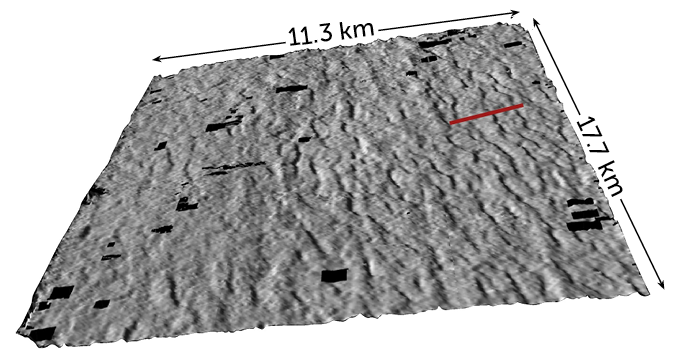The asteroid affect that slew the dinosaurs could have additionally not directly sculpted the biggest ripple marks ever discovered on Earth.
A collection of ridgelike constructions greater than three tales excessive and spaced almost two Eiffel Towers aside look like buried about 1,500 meters beneath central Louisiana. The outsized options are megaripples formed by an enormous tsunami generated by the Chicxulub asteroid affect, researchers report within the Sept. 15 Earth and Planetary Science Letters.
“It’s simply attention-grabbing that one thing that occurred 66 million years in the past might be so nicely preserved, buried 5,000 toes down within the sediments of Louisiana,” says geologist Gary Kinsland of the College of Louisiana at Lafayette.
Ripple marks are repeating sequences of ridges usually discovered on sandy seashores or stream bottoms that type as wind or water flows over and strikes free sediment. However ripple marks on the seaside are sometimes centimeters in peak, whereas the constructions discovered by Kinsland’s crew have a median peak of 16 meters and are spaced about 600 meters aside.
Signal Up For the Newest from Science Information
Headlines and summaries of the most recent Science Information articles, delivered to your inbox
The marks’ form, measurement, orientation and site counsel that they fashioned after the Chicxulub asteroid crashed into what’s right now’s Yucatán Peninsula in Mexico, producing a tsunami that washed throughout the sediments of the Gulf of Mexico and over what’s now Louisiana, which was underwater on the time (SN: 11/2/17). Regardless of the tsunami’s width, nobody has ever discovered ripple marks fashioned by the wave earlier than.
Geologist Kaare Egedahl initially found the newly described ripples whereas trying to find coal deposits. Finding out on the College of Louisiana at Lafayette on the time, Egedahl had been combing by means of seismic reflection knowledge – 3-D photographs of buried rock and soil generated by underground sound waves — supplied by the Devon Power firm. Egedahl, now on the oil and gasoline firm Cantium, discovered the ripples atop a layer of rock thought to have fashioned from particles shaken up by the Chicxulub asteroid affect. He then shared his discovering with Kinsland.
 Subsurface megaripples (most pronounced close to the purple line) below Louisiana have been imaged utilizing mirrored sound waves that traveled by means of Earth’s crust
Subsurface megaripples (most pronounced close to the purple line) below Louisiana have been imaged utilizing mirrored sound waves that traveled by means of Earth’s crust
Martell Sturdy
“I knew the place that layer was from in geologic time, and I knew what occurred there,” Kinsland says. “I knew there needs to be a tsunami.”
The supposed ripple marks have been preserved all this time because of the depth at which they fashioned underwater, Kinsland says. Different research counsel that the area of present-day Louisiana during which the ripples took form was 60 meters under the ocean floor on the time. At that depth, the ripples would have been past the attain of tumultuous storm exercise that might have erased them. Then, over hundreds of thousands of years, the marks have been slowly buried by different sediments.
A smaller, analogous set of constructions could exist off the east coast of Japan. There, a repeating sequence of underwater dunes was reported to have appeared after the 2011 Tohoku earthquake and tsunami. These dunes look almost equivalent to the ripple marks buried beneath Louisiana, besides for his or her measurement, Kinsland says, supporting the notion that the taller constructions have been additionally produced by a tsunami, although considered one of a a lot bigger magnitude.
Nonetheless, there may be competition over whether or not the options beneath Louisiana actually are megaripples fashioned by the Chicxulub tsunami.
“It’s arduous to see how such a high-energy occasion might type ripple marks as a result of they’re often related to a lot calmer environments,” says sedimentologist Pedro J.M. Costa of the Universidade de Coimbra in Portugal. And ripple marks usually type from frequent and recurring wave movement, whereas tsunamis don’t have many waves, he explains. Costa, who’s an skilled on tsunami deposits, says that reconstructing the lay of the seafloor at the moment of the affect and conducting experiments might assist unravel the origins of the constructions discovered by Kinsland’s crew.
This new work is necessary as a result of it opens a dialogue, Costa says. “Possibly [the Chicxulub impact was] such a high-magnitude occasion that what we see in regular tsunami occasions don’t apply to this one.”



